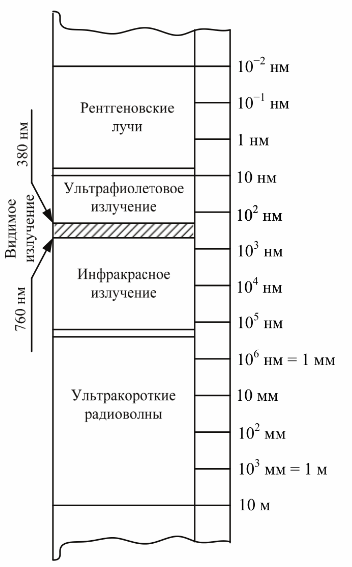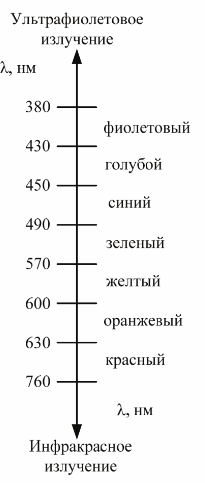Types of electromagnetic radiation
 Electromagnetic radiation (electromagnetic waves) — disturbance of electric and magnetic fields propagating in space.
Electromagnetic radiation (electromagnetic waves) — disturbance of electric and magnetic fields propagating in space.
Ranges of electromagnetic radiation
1 Radio waves
2. Infrared (thermal)
3. Visible radiation (optical)
4. Ultraviolet radiation
5. Hard radiation
The main characteristics of electromagnetic radiation are considered to be frequency and wavelength. The wavelength depends on the speed of propagation of the radiation. The speed of propagation of electromagnetic radiation in a vacuum is equal to the speed of light, in other media this speed is smaller.
The characteristics of electromagnetic waves from the point of view of the theory of oscillations and the concepts of electrodynamics are the presence of three mutually perpendicular vectors: vector wave, electric field strength vector E and magnetic field vector H.

Spectrum of electromagnetic radiation
 Electromagnetic waves - these are transverse waves (shear waves) in which the electric and magnetic field vectors oscillate perpendicular to the direction of propagation of the waves, but they differ significantly from waves on water and from sound in that they can be transmitted from source to receiver, including through vacuum.
Electromagnetic waves - these are transverse waves (shear waves) in which the electric and magnetic field vectors oscillate perpendicular to the direction of propagation of the waves, but they differ significantly from waves on water and from sound in that they can be transmitted from source to receiver, including through vacuum.
Common to all types of radiation is the speed of their propagation in a vacuum equal to 300,000,000 meters per second.
Electromagnetic radiation is characterized by a frequency of oscillation, indicating the number of complete cycles of oscillation per second or wavelength, i.e. the distance that the radiation spreads during one oscillation (over one period of oscillation).
The frequency of oscillation (f), the wavelength (λ) and the speed of radiation propagation (c) are related to each other by the relation: c = f λ.
Electromagnetic radiation is usually divided into frequency ranges... There are no sharp transitions between the ranges, they sometimes overlap, and the boundaries between them are arbitrary. Since the rate of propagation of radiation is constant, the frequency of its oscillations is strictly related to the wavelength in a vacuum.
Ultrashort radio waves are commonly divided into meter, decimeter, centimeter, millimeter, and submillimeter or micrometer. Waves with a length λ of less than 1 m (frequency above 300 MHz) are also called microwaves or microwave waves.
Infrared radiation — electromagnetic radiation occupying the spectral region between the red end of visible light (with a wavelength of 0.74 microns) and microwave radiation (1-2 mm).
Infrared radiation occupies the largest part of the optical spectrum.Infrared radiation is also called "thermal" radiation because all bodies, solid and liquid, heated to a certain temperature emit energy in the infrared spectrum. In this case, the wavelengths emitted by the body depend on the heating temperature: the higher the temperature, the shorter the wavelength and the higher the emission intensity. The emission spectrum of an absolute black body at relatively low (up to a few thousand Kelvin) temperatures lies mainly in this range.
Visible light is a combination of seven primary colors: red, orange, yellow, green, cyan, blue, and violet. But neither infrared nor ultraviolet is visible to the human eye.
Visible, infrared and ultraviolet radiation make up the so-called optical spectrum in the broadest sense of the word. The most famous source of optical radiation is the Sun. Its surface (photosphere) is heated to a temperature of 6000 degrees and glows with a bright yellow light. This part of the spectrum of electromagnetic radiation is perceived directly by our senses.
Radiation in the optical range occurs when bodies are heated (infrared radiation is also called thermal) due to the thermal motion of atoms and molecules. The more the body heats up, the higher the frequency of its radiation. With some heating, the body begins to glow in the visible range (incandescence), first red, then yellow, etc. Conversely, radiation from the optical spectrum has a thermal effect on bodies.
In nature, we most often encounter bodies emitting the light of a complex spectral composition consisting of wills of different lengths.Therefore, the energy of visible radiation affects the light-sensitive elements of the eye and causes a different sensation. This is due to the different sensitivity of the eye. to radiations of different wavelengths.

Visible part of the radiative flux spectrum
In addition to thermal radiation, chemical and biological reactions can serve as sources and receivers of optical radiation. One of the most famous chemical reactions, which is a receiver of optical radiation, is used in photography.
Hard beams... The boundaries of the X-ray and gamma radiation regions can only be determined very tentatively. For general orientation, it can be assumed that the energy of X-ray quanta lies in the range of 20 eV — 0.1 MeV, and the energy of gamma quanta is more than 0.1 MeV.
Ultraviolet radiation (ultraviolet, UV, UV) — electromagnetic radiation occupying the range between visible and X-ray radiation (380 — 10 nm, 7.9 × 1014 — 3 × 1016 Hz). The range is conditionally divided into near (380-200 nm) and far or vacuum (200-10 nm) ultraviolet, the latter is so named because it is intensively absorbed by the atmosphere and is studied only with vacuum devices.
Long-wave ultraviolet radiation has a relatively low photobiological activity, but it can cause pigmentation of human skin, has a positive effect on the body. The radiation of this sub-range is able to cause some substances to glow, which is why it is used for luminescence analysis of the chemical composition of products.
Medium-wave ultraviolet radiation has a tonic and therapeutic effect on living organisms.It is capable of causing erythema and sunburn, converting vitamin D, necessary for growth and development, into an absorbable form in the body of animals, and has a powerful anti-rickets effect. Radiation in this subrange is harmful to most plants.
Short-wave ultraviolet treatment It has a bactericidal effect, which is why it is widely used for water and air disinfection, disinfection and sterilization of various equipment and vessels.
The main natural source of ultraviolet radiation on Earth is the Sun. The ratio of the intensity of UV-A and UV-B radiation, the total amount of UV rays reaching the Earth's surface, depends on various factors.
Artificial sources of ultraviolet radiation are diverse. Artificial sources of ultraviolet radiation today are widely used in medicine, preventive, sanitary and hygienic institutions, agriculture, etc. significantly greater opportunities are provided than when using natural ultraviolet radiation radiation.
